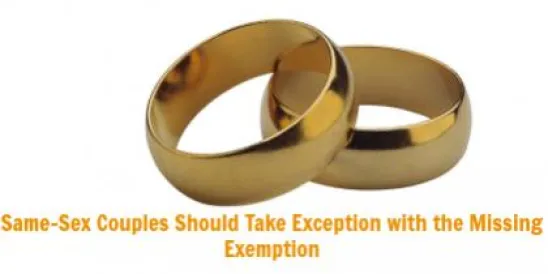On June 26, 2015, the U.S. Supreme Court ruled in Obergefell v. Hodges that states must license and recognize a marriage between two people of the same sex. Despite being a landmark decision affecting same sex couples whose marriage rights will now be recognized, as shown in the FAQs below, the ruling's direct impact on employers’ benefit plans is limited.
-
Do I have to treat same sex spouses the same as opposite sex spouses for qualified retirement plan (e.g. 401(k) plan) purposes?
Yes, but employers already had to treat same and opposite sex spouses equally based on the IRS guidance that followed the Supreme Court’s Windsor ruling. Pursuant to that guidance, retirement plan spousal rights apply to same and opposite sex spouses equally. Further, that guidance provides that the determination of whether an individual is a spouse is based on the “state of celebration” – i.e., the state in which the couple entered into the marriage. As all states will now need to permit same sex couples to marry, couples will no longer need to travel to other states to get married. Employers should review how they have defined spouse to determine whether any change is required.
-
How does the ruling affect employers who offer health coverage to domestic partners?
The ruling does not change the laws or treatment of domestic partners who are offered health coverage. This is true whether the partners are same or opposite sex. For example, employers offering health coverage for domestic partners must still impute the value of that coverage in the employee’s income for federal tax purposes (unless the domestic partner meets certain tax dependency rules). Some employers may want to stop offering coverage for domestic partners because the partners can now get married in any state. However, some states, including California, still have laws regarding the treatment of domestic partners. Employers wishing to change their domestic partner benefits should consider these state laws before making any change.
-
Do I have to offer health coverage to employees’ same sex spouses?
Employers are not required to offer any group health coverage to spouses. (The employer mandate under the Affordable Care Act mandates coverage for dependent children, not spouses.) However, employers who offer coverage to opposite sex spouses only will likely face state and federal discrimination claims. It is not clear at this point how such discrimination claims will apply to employers with religious objections.
-
What are the tax consequences of offering health coverage to same sex spouses?
Following the Supreme Court’s earlier Windsor decision and subsequent guidance, it is clear that same sex spouses are treated the same as opposite sex spouses for federal tax purposes. This generally means the value of the coverage is not included in the employee’s income and employee paid premiums may be paid pre-tax (assuming the employer has a Section 125 plan). However, some states that did not follow the federal rules required different tax treatment and employers providing health coverage to employees’ same sex spouses had to impose different tax consequences for state tax purposes. It seems clear from this decision that states will not be able to impose such different treatment going forward. As a result, employers who were previously imputing the value of a same sex spouse’s health coverage in the employee’s income for state tax purposes should stop doing so. What is still unclear is whether any retroactive change will be required with respect to these states.
-
Does the change in law create a change in status/special enrollment right for same sex spouses?
This may depend on the terms of the plan. If an employer’s plan followed the federal guidance and determined marital status based on the state of celebration, no status change has occurred. However, if the plan defined spouse based on where the employee resides and the employee and his or her same sex spouse reside in a state that did not recognize same sex marriage prior to the Obergefell decision, the relationship must now be recognized by the state and the spouse is now eligible under the terms of the plan. While not specifically addressed in the 125 plan change in status rules, this would appear to be an event that causes the spouse to satisfy eligibility requirements and be eligible for a mid-year enrollment.





 />i
/>i

